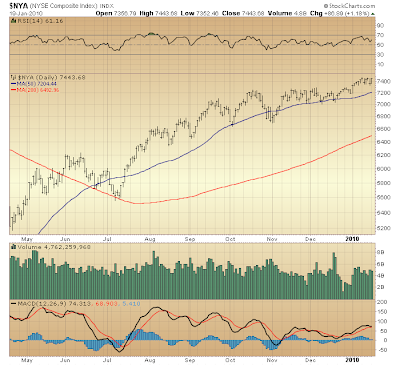Let's take a look under the covers and get an objective sense of the broad market's health. As you know, the case I make regarding the counter-trend rally off March '09 bottom is all things are not what they seem. This is to say conditions supportive of an advance with staying power simply are not present.
This conclusion is substantiated contrasting index performance with coincident technical measures and noting how the latter belie the former. Tonight, we will demonstrate this via the NYSE new 52-week high-low differential...


First, set your sight on early-October 2009. Post-March '09 bottom, this was the first instance when the NYSE Composite traded above levels of one year prior.
With this in mind, then, the marked bump higher in the NYSE new 52-week high-low differential, starting in July '09 and carrying into September seems rather impressive. Remember, the NYSE Composite at that time was trading below where it stood a year earlier, so the expansion in new 52-week highs appears noteworthy. Or at least it would seem anyway...
That is until you consider the NYSE new 52-week high-low differential from mid-October '09 to present ... at a time when the NYSE Composite was trading well over 60% higher than its worst levels during the year prior.
Right off the bat, the relatively modest expansion in new 52-week highs during October '09 (in comparison to September '09) is conspicuous considering that, the year prior (October '08) the NYSE Composite was not only crashing lower, but something on the order of 89% of all NYSE-listed issues were setting new 52-week lows (an all-time record!).
Given this, the NYSE new 52-week high-low differential should have risen parabolically during October '09, as the NYSE Composite rose to a new high, post-March '09 bottom. Yet this was not the case at all. Again, the increase in the NYSE new 52-week high-low differential was only relatively modest.
Strange, no? No! Not when NYSE leadership is thinner than Gandhi.
Now, at the moment I can only speculate what was behind the bump in the NYSE new 52-week high-low differential from July-September '09. I would be willing to bet the greater preponderance of NYSE-listed "issues" setting new 52-week highs over that interim were ETFs, some possibly not even existing a year prior, and some likely anchored to the bond market (corporates, municipals, junk, etc). To a much lesser extent, that thin minority of NYSE-listed issues not registering new 52-week lows from October '08 - March '09 also might have been setting new 52-week highs from July-September '09. (Just how many of these likewise were among those relatively few issues perceived "safe" by the fact they are widely held is unknown.)
Bottom line is far more NYSE-listed issues should have been registering new 52-week highs from mid-October '09 onward. Yet what instead has been revealed is just how incredibly thin is NYSE leadership behind the post-March '09 counter-trend rally. Considering this in conjunction with the added disparity revealed via the NYSE cumulative advance-decline line, the case previously made suggesting NYSE-listed issues are being distributed finds further substantiation, as does conviction that, the market's advance off March '09 bottom is, in fact, but a counter-trend rally in a larger bear market.
A few final items of note here...
First, despite the NYSE Composite having exceeded its October '09 peak on a number of occasions over the past three months, the NYSE new 52-week high-low differential did not exceed its October '09 peak until January 11, 2010 (on the day the NYSE Composite set its intra-day high, post-March '09 bottom). End of year (2009) "window dressing" delivered a slight surge in the high-low differential ... and start of year (2010) positioning a further surge still, at last taking the differential to a new high, post-March '09 bottom.
As I mentioned following this, January 11th's "technical confirmation" of the NYSE Composite's move higher, one ought expect the index to trade a bit higher still as a result. Yet look how already the new 52-week high-low differential is coming in as the NYSE Composite challenges its January 11th high. Only further is leadership thinning as the NYSE Composite trades very near its peak, post-March '09 bottom.
This begs the question, then: is this a technical divergence signaling top, or is a more pronounced divergence yet to develop? Time will tell.

* * * * *
© The Risk Averse Alert — Advocating a patient, disciplined approach to stock market investing. Overriding objective is limiting financial risk. Minimizing investment capital loss is a priority.
Analysis centers on the stock market's path of least resistance. Long-term, this drives a simple strategy for safely investing a 401(k) for maximum profit. Intermediate-term, investing with stock index tracking-ETFs (both their long and short varieties) is advanced. Short-term, stock index options occasionally offer extraordinary profit opportunities when the stock market is moving along its projected path.
Nothing is set in stone. Nor is the stock market's path of least resistance always known. More often than not, there are no stock index option positions recommended.
 There's an easy way to boost your investment discipline...
There's an easy way to boost your investment discipline...Get Real-Time Trade Notification!



















